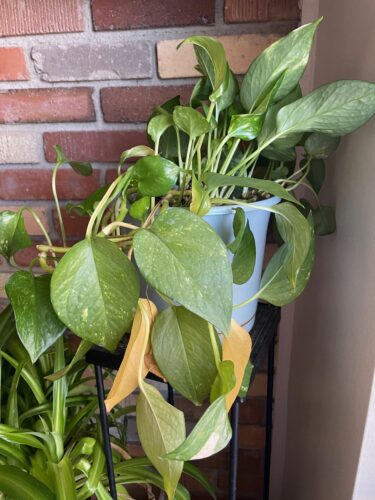Garden Help Desk: What to do when your pothos leaves turn yellow

Courtesy photo
Sometimes a houseplant problem isn't because of disease or insects. Plant stress (over/underwatering, too much or too little light, temperature problems) can cause leaves to yellow. This plant looks healthy overall, and the yellow leaves are just naturally aging. They can be snipped or snapped off to improve the appearance of the plant.Some of the leaves on my Pothos plant are turning yellow. What should I do?
There are a few possible reasons why your Pothos plant has yellowing leaves.
If the yellowing is showing up only on the oldest leaves, then your plant probably needs nitrogen. Plants will move nitrogen from their older leaves to the new developing leaves is there isn’t enough nitrogen in their potting soil. March is the time when we normally start fertilizing houseplants after letting them rest for the winter. Consider a slow-release fertilizer added to the soil or a water-soluble fertilizer at one-quarter to one-half strength with every watering. Don’t use more fertilizer than recommended on the label and stop fertilizing in late summer.
If the yellowing is scattered throughout your plant, or seems to be random, then you’ll want to consider other causes of yellowing leaves.
- Is your plant sitting in a cold location near a window or a drafty door? Moving your plant to a warmer location may solve the problem.
- Have you been watering too frequently, or letting your plant get drought-stressed between waterings? Either one can cause yellowing. Proper watering will make a difference.
- Are the yellow leaves older? Does the rest of the plant look healthy? As leaves reach “old age,” they may naturally yellow and then drop.
- Have you moved your plant to a new location? If the plant has been moved to a lower light setting, that could cause leaf yellowing. You’ll need to make sure your plant is getting enough light if that is the problem.
- Have you been fertilizing in the summer with only nitrogen? The yellowing could be the result of a nutrient deficiency that could be corrected with a fertilizer that also contains phosphorus and potassium plus minor and micronutrients.
Since there are several possibilities, you’ll need to do some detective work and see which possibility seems to be the most likely, then do what needs to be done to correct the problem. Be patient; it may take some time for your plant to recover.
How can I succeed with cilantro? I’ve tried to grow it for two years now and it always goes to seed right before it’s big enough to harvest.
Some gardeners are happy to see their cilantro plants go to seed because they want to collect the seeds, also known as Coriander. But most of us grow these plants for the leaves we’ll use in salsas, salads, dips and soups. Even if your goal is collecting the seeds, you want your plants to reach a mature size with enough leaves to provide energy for flower and seed production.
Cilantro is a cool-season annual herb, so you can’t expect several cuttings over the summer from the same plants. That doesn’t mean there’s nothing you can do to keep your harvest going for several weeks, though.
Selecting a variety described as being slow to bolt (going to seed).
Begin your cilantro planting with good soil preparation. Choose a location with full sun and amend the soil with some good plant-based compost.
Cilantro does best when started from seed in the garden. Follow the seed packet directions for seed depth and spacing and plant your cilantro seeds in the spring. Cilantro needs cool temperatures and planting your seeds in the spring as soon as danger of frost is past will give the plants more days of ideal growing conditions. If you can’t plant until early summer, choose a location where you can provide some afternoon shade to delay the warmer temperatures. Established cilantro will tolerate some light frosts, so it can also be planted in the late summer or early fall for some end of season harvests.
Cilantro does best with regular watering but doesn’t like wet soils. A layer of compost or grass clippings around the plants will help to hold in moisture and help to space out watering without causing drought stress.
Side dress your plants once or twice while they’re growing with a light application of nitrogen fertilizer (about ¼ cup of ammonium sulfate for a 5-foot-by-5-foot planting). Nitrogen promotes leafy growth; not our long-term goal for tomatoes and peppers, but just what we want from leafy greens like cilantro. Don’t overdo it though; too much nitrogen will produce less flavorful plants.
You can extend your cilantro harvest with succession planting- planting more cilantro every two-to-three weeks in the spring and early summer. Your last planting may need some afternoon shade to keep it productive.
Harvest by cutting bunches of leaves about 1-2 inches above the soil line. You can expect to get two cuttings from your plants, but cilantro is a short-lived herb and will fade and go to seed once our hot weather arrives. If you get two nice cuttings from your plants, you’ve had a successful season!
